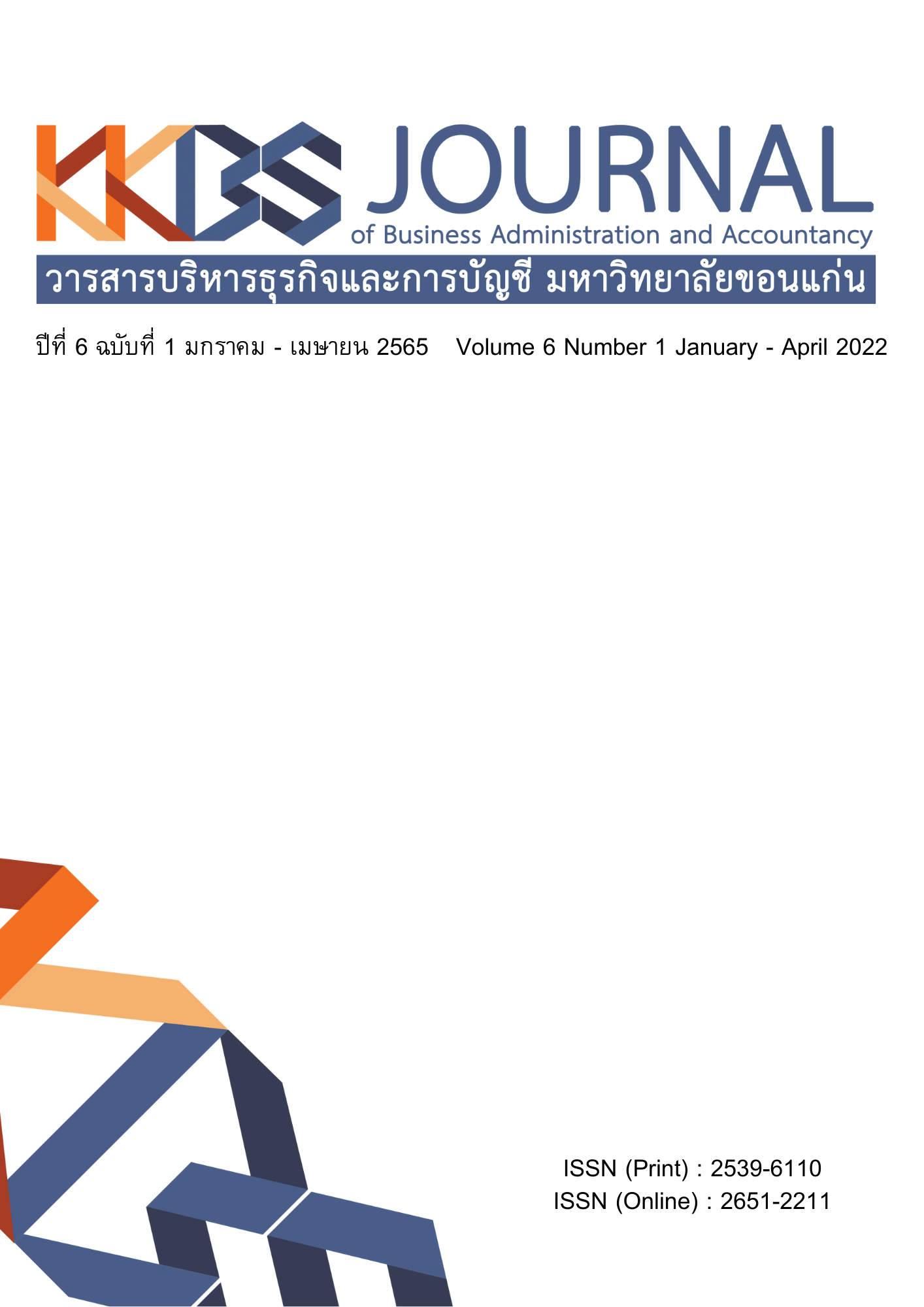ปัจจัยที่มีผลต่อการพัฒนาเป็นมหาวิทยาลัยสีเขียวของมหาวิทยาลัยเอกชนไทย
Main Article Content
บทคัดย่อ
การวิจัยมีวัตถุประสงค์เพื่อศึกษาปัจจัยที่มีผลต่อการพัฒนาเป็นมหาวิทยาลัยสีเขียวของมหาวิทยาลัยเอกชนไทย ใช้แบบสอบถามเป็นเครื่องมือในการเก็บรวบรวมข้อมูลจากกลุ่มตัวอย่างที่เป็นมหาวิทยาลัยเอกชนในประเทศไทย จำนวน 42 แห่ง ใช้การวิเคราะห์สมการโครงสร้างแบบมิมิคเพื่อทดสอบสมมติฐาน ผลการวิจัยพบว่า ปัจจัยที่มีผลต่อการพัฒนาเป็นมหาวิทยาลัยสีเขียว ได้แก่ ความชัดเจนของนโยบาย ภาวะผู้นำและวิสัยทัศน์ของผู้บริหาร การมีส่วนร่วมของบุคลากร การติดตามประเมินผล สมรรถนะองค์กร และการสนับสนุนจากภายนอก ปัจจัยทั้งหมดสามารถร่วมกันทำนายการพัฒนาเป็นมหาวิทยาลัยสีเขียวได้ร้อยละ 60
Article Details

This work is licensed under a Creative Commons Attribution-NonCommercial-NoDerivatives 4.0 International License.
บทความที่ได้รับการตีพิมพ์ในวารสารเป็นความคิดเห็นของผู้เขียน มิใช่ความคิดเห็นของกองบรรณาธิการและคณะผู้จัดทำวารสาร และบทความที่ได้รับการตีพิมพ์เป็นลิขสิทธิ์ของวารสารบริหารธุรกิจและการบัญชี มหาวิทยาลัยขอนแก่น
References
Buakhao, T. & Phetcharanont, M. (2012). Policy and strategy format toward green universities a case of Thaksin University, Phatthalung Campus. Journal Faculty of the Architecture, King Mongkut’s Institute of Technology Ladkrabang, 14(1), 40-55. (In Thai)
Byrne, B. (2001). Structural equation modeling with AMOS: Basic concept, application, and programming. Mahwah, NJ.: Lawrence Erlbaum Associate.
Chidchob, T. & Pianthong, N. (2018). The causal model of executive commitment, customer pressure, green purchasing, and business performance of manufacturing industries in Thailand: A review. Executive Journal, 38(1), 79-90. (In Thai)
Cronbach, L.J. (1951). Coefficient alpha and the internal structure of tests. Psychometrika, 16(3), 297-334.
Geng, Y., Xue, B., Liu, K. & Fujita, T. (2013). Creating a “green university” in China: A case of Shenyang University. Journal of Cleaner Production, 61, 13-19.
Hair, J., Black, W., Babin, B. & Anderson, R. (2014). Multivariate data analysis with readings. 7th ed. England: Pearson.
Hambleton, R.K. (1984). Validating the test scores. In R.A. Berk. (Ed). A guide to criterion referenced test construction. (pp.199–223). Baltimore: The Johns Hopkins University Press.
Hungate, B., Koch, G. & Chopin, M. (2007). Greenhouse Gas Emissions at Northern Arizona University: Strategies for Reduced Emissions. Interdisciplinary Approaches to Climate Change Mitigation Spring, 2007.
Kline, R. (2005). Principle and practice of structural equation modeling. New York: Guilford.
Lozano, R. (2010) Diffusion of sustainable development in universities’ curricula: An empirical example from Cardiff University. Journal of Cleaner Production, 18(7), 637-644.
Mongkhonvanit, P., Panklib, T. & Bhalla, S.K. (2015). A Survey of Green University: Challenges and opportunities. International Journal of the Computer, the Internet and Management, 23(2), 20-26.
Mungai, D.N. (2017). Tracking environmental sustainability performance of Public Universities in Kenya. Universal Journal of Educational Research, 5(11), 1869-1877.
Nunnally, J.C. (1967). Psychometric theory. New York: McGraw-Hill.
Office of Natural Resources and Environmental Policy and Planning. (2014). Information system to support strategy. Retrieved December 5, 2019, from https://www.egov.go.th/th/e-government-service/1460/ (In Thai)
Rodtassana. (2015). Green university. HCU Journal, 18(36), 171-187. (In Thai)
Sonetti, G., Lombardi, P. & Chelleri, L. (2015). True green and sustainable university campuses? Toward a clusters approach. Sustainability, 8, 83.
Tiyarattanachai, R. & Hollmann N.M. (2016). Green campus initiative and its impacts on the quality of life of stakeholders in Green and Non-Green campus universities. SpringerPlus, 5, 84.
Tourism Authority of Thailand. (2019). Green business. Retrieved December 5, 2019, from https://7greens.tourismthailand.org/green-content (In Thai)
Tu, J. & Hu, M. (2017). Building on management model of modern green university. Advances in Social Science, Education, and HumanitiesResearch, 155, 391-396.
UI GreenMetric Secretariat. (2018). UI GreenMetric World University Rankings. Retrieved December 5, 2019, from http://www.greenmetric.ui.ac.id/
UI GreenMetric Secretariat, (2020). Overall, rankings 2020. Retrieved November 15, 2020, from http://greenmetric.ui.ac.id/overall-rankings-2020/
USGBC. (2013). The Campus as a living laboratory. Retrieved November 15, 2020, from http://www.centerforgreenschools.org
Wattanathum, S. (2015). Guidelines for the green campus development. Master of Engineering Program in Engineering Management, Siam University. (In Thai)
Xing, X., Wang, J. & Tou, L. (2019). The relationship between green organization identity and corporate environmental performance: The mediating role of sustainability exploration and exploitation innovation. International Journal of Environmental Research and Public Health, 16(921), 1-16.

